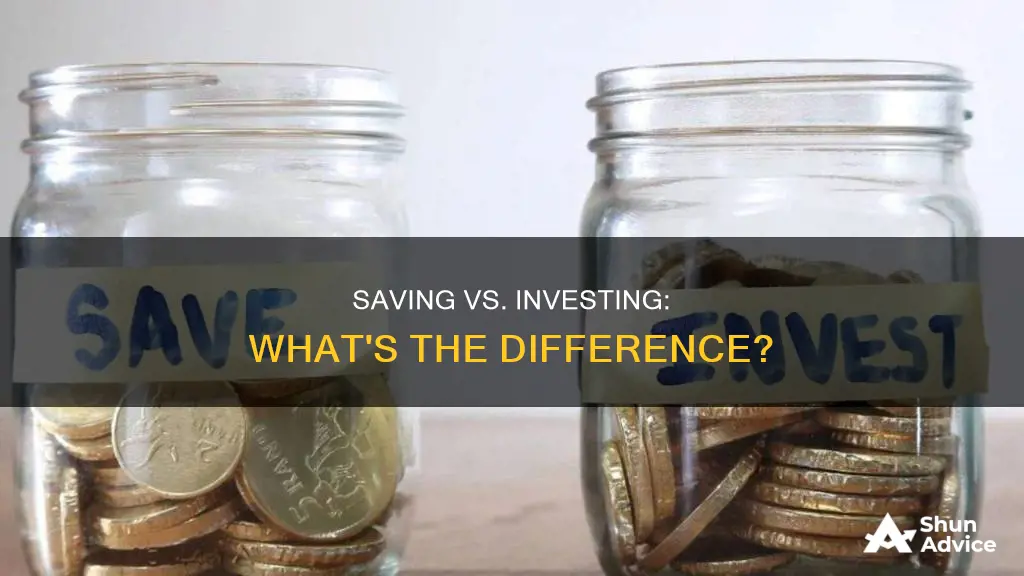
Saving and investing are both important concepts for building a sound financial future, but they are not the same thing. Saving typically results in a lower return with little to no risk, while investing allows for higher returns but comes with the risk of loss. Saving is generally used for short-term goals, such as buying a new gadget or going on vacation, while investing is geared towards long-term financial goals like retirement or saving for a child's education. Understanding the differences between saving and investing is crucial for making informed decisions about how to allocate your money effectively and achieve your financial aspirations.
| Characteristics | Values |
|---|---|
| Risk | Saving: Low |
| Investing: High | |
| Returns | Saving: Low |
| Investing: High | |
| Time horizon | Saving: Short-term |
| Investing: Long-term | |
| Liquidity | Saving: High |
| Investing: Low | |
| Asset types | Saving: Bank products such as savings accounts, money markets and CDs |
| Investing: Stocks, ETFs, bonds and mutual funds | |
| Emergency funds | Saving: Yes |
| Investing: No |
What You'll Learn

Saving is for the short-term, investing is for the long-term
Saving and investing are both important components of a healthy financial plan. Saving is for the short-term, while investing is for the long-term.
Saving is an essential part of personal finance that involves setting aside money for future use. Think of it as putting your money in a piggy bank, but instead of an actual piggy bank, you can use a savings account or a certificate of deposit (CD) that earns interest over time. You can save for different reasons, such as buying a new gadget, going on vacation, or having an emergency fund for unexpected expenses. Saving is a great way to meet short-term financial goals and prepare for unexpected situations, such as car repairs or medical bills. By putting aside money regularly, you can build up a cushion to help you through tough times. Savings are generally low-risk, meaning your money is safe, but the interest rates received are also low.
Investing, on the other hand, is a way to grow your money over time by putting it into financial instruments such as stocks, bonds, and mutual funds. It typically comes with a longer-term horizon, such as children's college funds or retirement plans. Investing involves taking on some risk but also offers the potential for higher returns. It is important to choose investments that align with your goals, risk tolerance, and time horizon. The longer you can invest, the more risk you can take on as you have more time to ride out the ups and downs of the stock market.
When deciding whether to save or invest, consider your financial situation, goals, and risk tolerance. If you need money in the short term, saving is a safer option. If you are saving for retirement or other long-term goals, investing is a better choice to achieve higher returns.
Five Things to Avoid When Trading Investments
You may want to see also

Saving is about preservation, investing is about growth
Saving and investing are both important components of a healthy financial plan. However, they serve different purposes: saving is about preservation, while investing is about growth.
When you save money, you're putting it aside in a safe place, typically a bank account, to use at a later date. This could be for short-term goals, such as buying a new gadget or going on vacation, or to cover unexpected expenses, like car repairs or medical bills. Saving is a way to meet short-term financial goals and provides a financial safety net for emergencies. It's generally a low-risk option, as your money is easily accessible and protected by the Federal Deposit Insurance Corporation (FDIC) in many cases, up to $250,000 per depositor. However, the trade-off is that savings accounts offer low interest rates, which may not keep up with inflation, resulting in a loss of purchasing power over time.
On the other hand, investing is about growing your money over time. It involves putting your money into financial instruments, such as stocks, bonds, or mutual funds, with the potential for higher returns than savings accounts. Investing is typically associated with longer-term goals, such as saving for retirement, a child's college fund, or a down payment on a house. It usually comes with a longer time horizon, allowing you to ride out the ups and downs of the financial markets. While investing offers the opportunity for higher returns, it also carries a higher risk of losing money. There are no guarantees, and the value of your investments can fluctuate.
Both saving and investing play crucial roles in personal finance. Saving provides a sense of security and helps you prepare for unexpected situations, while investing offers the potential for higher long-term returns to achieve your financial goals.
When deciding whether to save or invest, it's essential to consider your specific goals and timeframes. For short-term goals or emergencies, saving is usually the better option as it provides easy access to your funds with minimal risk. For longer-term goals, investing becomes more attractive as it offers the potential for higher returns, even though it comes with a higher risk of losing money.
In conclusion, saving is about preservation—keeping your money safe and accessible for short-term goals and emergencies. Investing, on the other hand, is about growth and taking on some risk to achieve higher returns over the long term. Both are important components of a comprehensive financial strategy.
The Salem Investment Partners' Journey with Will Johnson
You may want to see also

Saving is low-risk, investing is high-risk
Saving and investing are both important concepts for building a sound financial future, but they are not the same thing. Saving is generally considered low-risk, while investing is high-risk. Here are some key points to illustrate this difference:
Risk and Returns
Saving typically results in lower returns compared to investing, but it also carries minimal risk. On the other hand, investing offers the opportunity for higher returns but comes with the risk of losing money. Saving is a good option for those who want to play it safe and are satisfied with modest returns. In contrast, investing is suitable for those who are willing to take on more risk in pursuit of potentially higher profits.
Time Horizons
Saving is often associated with short-term financial goals, such as buying a new gadget, going on vacation, or building an emergency fund. These are goals that you want to achieve within a year or less. Investing, on the other hand, usually has a longer-term horizon, typically five years or more. This is because investments need time to grow and ride out the inevitable ups and downs of the financial markets.
Types of Assets
When you think of saving, consider bank products such as savings accounts, money market accounts, and certificates of deposit (CDs). These are generally very safe and liquid, allowing you to access your funds quickly when needed. Investing, on the other hand, involves purchasing assets like stocks, bonds, mutual funds, and exchange-traded funds (ETFs). These assets have the potential for higher returns but also come with a higher risk of loss.
Emergency Funds and Debt
It is generally recommended to prioritize saving over investing when it comes to building an emergency fund. Financial advisors suggest having three to six months' worth of living expenses set aside in a safe and easily accessible savings account. Additionally, if you have high-interest debt, such as credit card balances, it is advisable to focus on paying them off before investing.
Inflation
While saving is a crucial part of financial planning, it is important to combine it with investing to maintain purchasing power over time. Savings accounts often provide low-interest rates, which may not keep up with inflation. On the other hand, investing in a diversified portfolio of stocks and other assets can help you stay ahead of inflation and increase your purchasing power over the long term.
Whole Life Insurance: Paying for Protection or Investing in a Policy?
You may want to see also

Saving is for emergencies, investing is for retirement
The Importance of Saving for Emergencies
Saving is an essential part of personal finance. It involves setting aside money for future use, often in a savings account or a certificate of deposit (CD) that earns interest over time. One of the key advantages of saving is that it provides a financial safety net for unexpected events and short-term financial goals, such as buying a new gadget, going on vacation, or covering emergency expenses. By regularly putting money aside, individuals can build a cushion to help them navigate through tough times.
The Benefits of Saving
Saving offers several benefits, including:
- Financial security: It ensures that individuals have funds available when they need them, providing peace of mind and protection against financial shocks.
- Low risk: Savings are generally considered low-risk investments, meaning there is a minimal chance of losing money.
- Liquidity: Savings accounts offer quick access to funds, making it easy to withdraw money when needed.
- Interest earnings: While the interest rates on savings accounts may be low, they still provide an opportunity to earn returns on your money.
The Drawbacks of Saving
However, there are also some drawbacks to consider:
- Low returns: Savings accounts typically offer lower returns compared to riskier investments, which may result in missing out on potential higher returns.
- Inflation risk: Savings may lose purchasing power over time due to inflation, affecting their overall value.
Investing for Retirement
Investing, on the other hand, is a strategy focused on growing your money over time by putting it into financial instruments such as stocks, bonds, and mutual funds. Investing typically involves taking on more risk than saving but also offers the potential for higher returns. It is commonly associated with long-term financial goals, such as retirement planning.
The Benefits of Investing
Investing offers several advantages, including:
- Higher return potential: Investments like stocks have the potential to provide much higher returns compared to savings accounts, especially over the long term.
- Beating inflation: By investing in a diversified portfolio, individuals can generally beat inflation and increase their purchasing power over time.
- Long-term wealth accumulation: Investing is an effective way to accumulate wealth over the long term, making it a crucial component of retirement planning.
The Drawbacks of Investing
However, there are also drawbacks and risks associated with investing:
- Risk of loss: Investing always carries the risk of losing money, especially in the short term, as the value of assets can fluctuate.
- Volatility: The stock market and other investments can be volatile, and there is no guarantee of returns.
- Complexity: Investing can be complex and requires research and discipline to make informed decisions.
Striking a Balance
Both saving and investing are essential components of a comprehensive financial plan. While saving is crucial for building an emergency fund and meeting short-term goals, investing is vital for achieving long-term financial goals, such as retirement. It is important to find the right balance between saving and investing based on your financial situation, goals, and risk tolerance.
When Will Investments Rebound?
You may want to see also

Saving is for purchases, investing is for education
Saving and investing are both important components of a healthy financial plan. While they are often used interchangeably, they are distinct concepts with different purposes. Saving is for purchases, while investing is for education, and understanding the difference is crucial for achieving financial security and stability.
Saving involves setting aside money for future use, typically in a safe and low-risk account such as a savings account or a certificate of deposit (CD). Saving is ideal for short-term financial goals, such as buying a new gadget or going on vacation, as well as for building an emergency fund to cover unexpected expenses. It provides liquidity and easy access to funds, making it suitable for goals that are relatively close in the future. Saving is a conservative approach that prioritises the preservation of capital, ensuring that your money remains secure and readily available.
On the other hand, investing involves putting your money into assets that have the potential to grow in value over time. Examples of investments include stocks, bonds, mutual funds, and real estate. Investing is typically associated with a higher level of risk, as the value of these assets can fluctuate. However, it also offers the opportunity for higher returns compared to traditional savings accounts. Investing is suitable for long-term financial goals, such as saving for a child's education, planning for retirement, or purchasing a home.
While saving is essential for financial stability, investing is crucial for wealth generation. Investing helps beat inflation, ensuring that your money maintains its purchasing power over time. Additionally, investing allows you to take advantage of compound interest, where the returns generated are reinvested to earn even more returns. This exponential growth potential makes investing a powerful tool for achieving long-term financial goals.
To summarise, saving is ideal for short-term goals and provides a financial safety net, while investing is geared towards long-term goals and offers the potential for higher returns. A well-rounded financial strategy incorporates both saving and investing, ensuring that you have funds available for immediate needs while also growing your wealth for the future.
Cash Hoarding: Fear or Greed?
You may want to see also
Frequently asked questions
Saving is putting your money in safe and secure places, such as savings accounts, checking accounts, and certificates of deposit, where you can access it at any time. Your deposits may be insured by the Federal Deposit Insurance Corporation (FDIC) at some banks, offering protection from loss. However, the trade-off is that your money earns a low return.
Investing, on the other hand, offers the opportunity for higher returns, but with a greater chance of losing your money. When you invest in securities, mutual funds, and similar investments, your principal amount is not federally insured, and you could lose it.
It is generally recommended to prioritize saving over investing if you don't have an emergency fund or if you'll need the money within a few years. Financial advisors suggest having three to six months' worth of living expenses in an emergency fund. Additionally, if you have short-term savings goals, such as a down payment on a house or an upcoming vacation, it's best to keep your money in a savings account where returns are guaranteed.
Investing is ideal for long-term financial goals, typically those that are at at least three to five years away. This could include retirement planning, building generational wealth, or funding expensive future goals like your children's education. Investing offers the potential for higher returns, allowing your money to grow faster than it would in a savings account.
Saving is a great way to ensure you have a financial cushion for unexpected expenses and to preserve your money. It is also easily accessible and offers predictable returns.
Investing, on the other hand, offers the potential for higher returns and can help you grow your money over time. It is a good option for long-term goals and can also provide a recurring income stream through investments like dividend-paying stocks or real estate.







